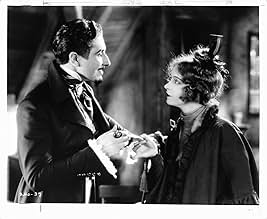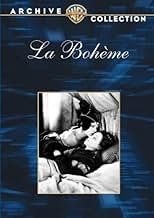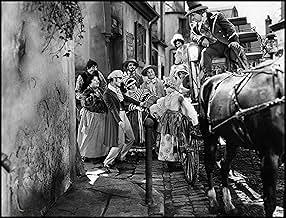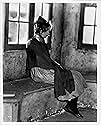NOTE IMDb
7,2/10
1,7 k
MA NOTE
Un groupe d'artistes affamés tente de survivre dans le Paris des années 1830, notamment une couturière et le futur dramaturge qu'elle aime.Un groupe d'artistes affamés tente de survivre dans le Paris des années 1830, notamment une couturière et le futur dramaturge qu'elle aime.Un groupe d'artistes affamés tente de survivre dans le Paris des années 1830, notamment une couturière et le futur dramaturge qu'elle aime.
- Réalisation
- Scénario
- Casting principal
- Récompenses
- 2 victoires au total
Mathilde Comont
- Madame Benoit
- (as Matilde Comont)
Eugene Pouyet
- Bernard
- (as Gene Pouyet)
Agostino Borgato
- Editor
- (non crédité)
Harry Crocker
- Bit Part
- (non crédité)
Blanche Payson
- Factory Supervisor
- (non crédité)
Avis à la une
Stories like this have a certain kind of timelessness and familiarity to them, because they are based around characters and situations which recur again and again in art and literature. And in the case of La Boheme, it is a central concept which has particular resonance for the passionately creative amongst us. For here we meet the romantic archetype of the artists who will die for their art – writers, painters and musicians, lovers and libertines all, starving in the garrets of 19th century Paris. The story comes from the 1896 Puccini opera, but elements of it crop up as recently as the 2001 movie Moulin Rouge! During this era, there wasn't really anyone better suited to playing the female lead than Lillian Gish, and perhaps there never has been. Tender, mysterious, as light and ethereal as a strip of gauze, she was in every way the tragic heroine. At her best when she played it subtle, her performance in La Boheme is wonderfully subdued. So much lies in the tiniest flicker of her face, such as that little curl of her lip when she gets her first glimpse of John Gilbert. Gilbert is not nearly as fine an actor as his leading lady, but he is again very much the right type for his part – an idealist with intelligent eyes and a warm smile. Other faces to look out for here are the very entertaining French actress Renée Adorée, and a rare glimpse of a silent-era Edward Everett Horton, although sadly before his comic talent was fully realised.
The director is King Vidor, himself a man with a burningly artistic approach to his medium, albeit one grounded enough in reality and focused enough in thought to make him a good professional. His shot composition shows a neat use of space, and confident handling of rhythm. But what really makes Vidor stand out is the smooth way he makes shots that little bit special. Take for example the scene in which Vicomte Paul first lays eyes on Gish. We get a travelling point-of-view shot as he watches one young woman walking alongside his carriage. The carriage then stops, the woman carries on walking to reveal Gish heading straight towards the camera. We then cut in to a close-up of her face. The moment jolts itself into our consciousness, and because the movement of the camera and the two women is logical, it draws us further into the film's world, rather than exposing the artifice of the medium. King Vidor was one of the best directors who ever lived, because he successfully bridged the gap between the stylish and the realistic.
The resultant picture is a good work of classic romantic tragedy, and ultimately one that relates more to fantasy and mythology than to any real world situation. Poverty and injustice play their parts in La Boheme, but they are presented in almost noble terms, like some depiction of suffering in a religious painting. Compare this to poverty-themed pictures made just a few years later during the depression, which were earthy, honest and very close to home. La Boheme on the other hand is more the agonising, bittersweet fairytale. And there is no shame in this – it is simply a part of the idealism of the 1920s and of silent cinema, a naïve but beautiful way of thinking that was very soon to vanish with the changing times.
The director is King Vidor, himself a man with a burningly artistic approach to his medium, albeit one grounded enough in reality and focused enough in thought to make him a good professional. His shot composition shows a neat use of space, and confident handling of rhythm. But what really makes Vidor stand out is the smooth way he makes shots that little bit special. Take for example the scene in which Vicomte Paul first lays eyes on Gish. We get a travelling point-of-view shot as he watches one young woman walking alongside his carriage. The carriage then stops, the woman carries on walking to reveal Gish heading straight towards the camera. We then cut in to a close-up of her face. The moment jolts itself into our consciousness, and because the movement of the camera and the two women is logical, it draws us further into the film's world, rather than exposing the artifice of the medium. King Vidor was one of the best directors who ever lived, because he successfully bridged the gap between the stylish and the realistic.
The resultant picture is a good work of classic romantic tragedy, and ultimately one that relates more to fantasy and mythology than to any real world situation. Poverty and injustice play their parts in La Boheme, but they are presented in almost noble terms, like some depiction of suffering in a religious painting. Compare this to poverty-themed pictures made just a few years later during the depression, which were earthy, honest and very close to home. La Boheme on the other hand is more the agonising, bittersweet fairytale. And there is no shame in this – it is simply a part of the idealism of the 1920s and of silent cinema, a naïve but beautiful way of thinking that was very soon to vanish with the changing times.
In 19th century Bohemia, artistic residents in the "Latin Quarter" of Paris suffer and starve. Lillian Gish (as Mimi) is a seamstress who can't pay the rent. John Gilbert (as Rodolphe) is an playwright with money problems of his own. Gilbert has been watching Gish, who lives in the neighboring attic apartment; he is taken by her innocent waif-like beauty. On the first of the month, neither Ms. Gish nor Mr. Gilbert are able to pay the rent, when the landlord visits. Gilbert, his roommates, and friends get some cash together; but Gish, a loner, is evicted. As Gish is preparing to leave the building, Gilbert and friends rescue her from street life. Then, Gish and Gilbert fall in love.
The film is most notable for its outstanding pairing of stars Gish and Gilbert, under the star direction of King Vidor. Mr. Vidor is strangely subdued by the period, and settings; but, his Paris street scenes are terrific. The meeting of Gish and lecherous Roy D'Arcy (as Vicomte Paul) is striking; and, Gish's tubercular crawl through the streets of Paris is most especially stunning.
The lovers of "La Bohème" face poverty and misunderstanding; but, mainly, it's Gish's "Mimi" making sacrifices for Gilbert's "Rodolphe". Gish's performance is indescribable. According to Vidor and co-workers, she may have put her life in danger to make the film's ending most realistic; and, it shows. Gilbert is in fine form, and characterization; according to Gish, he proposed during film-making. Renée Adorée (as Musette) and Karl Dane (as Benoit) standout among the oddly more well-fed Bohemians.
King Vidor directing Lillian Gish and John Gilbert in a prestigious M-G-M production is, of course, well worth seeing; but, the sum of their efforts do not produce the portended masterpiece. Gish's performance seems too outer-worldly for the rest of the cast; and, the story is unworthy. Cinematographer Hendrik Sartov contributes to some beautiful imagery; although, his soft focus lens, on Gish close-ups, is distracting during the early scenes. Happily, Gish, and photographer Sartov, returned to balanced perfection, in "The Scarlet Letter" (1926).
******** La Boheme (2/24/26) King Vidor ~ Lillian Gish, John Gilbert, Renee Adoree, Roy D'Arcy
The film is most notable for its outstanding pairing of stars Gish and Gilbert, under the star direction of King Vidor. Mr. Vidor is strangely subdued by the period, and settings; but, his Paris street scenes are terrific. The meeting of Gish and lecherous Roy D'Arcy (as Vicomte Paul) is striking; and, Gish's tubercular crawl through the streets of Paris is most especially stunning.
The lovers of "La Bohème" face poverty and misunderstanding; but, mainly, it's Gish's "Mimi" making sacrifices for Gilbert's "Rodolphe". Gish's performance is indescribable. According to Vidor and co-workers, she may have put her life in danger to make the film's ending most realistic; and, it shows. Gilbert is in fine form, and characterization; according to Gish, he proposed during film-making. Renée Adorée (as Musette) and Karl Dane (as Benoit) standout among the oddly more well-fed Bohemians.
King Vidor directing Lillian Gish and John Gilbert in a prestigious M-G-M production is, of course, well worth seeing; but, the sum of their efforts do not produce the portended masterpiece. Gish's performance seems too outer-worldly for the rest of the cast; and, the story is unworthy. Cinematographer Hendrik Sartov contributes to some beautiful imagery; although, his soft focus lens, on Gish close-ups, is distracting during the early scenes. Happily, Gish, and photographer Sartov, returned to balanced perfection, in "The Scarlet Letter" (1926).
******** La Boheme (2/24/26) King Vidor ~ Lillian Gish, John Gilbert, Renee Adoree, Roy D'Arcy
Lillian Gish is the main reason to watch this film, as the subtlety and range of her expressiveness is on full display here. She is simply magnificent. The film shows signs of creakiness and yet still carries an emotional impact, though I have to say, director King Vidor elongates things as he tries to wring every last ounce of pathos out of it. The film is also hampered by being silent, when you consider how powerful the music from Puccini's opera is.
Gish and John Gilbert were huge stars when this film was made, Gish especially, and there are moments when they light up the screen. My favorite is when they're out on a picnic and she dances about while he chases her. Look for the moment when he catches her, then holds her hands from behind and whispers something in her ear; her look of surprise changing to a backward glance as her body sways forward is wonderful. It's in these types of scenes and when the Vidor puts Gish's face in a tight shot that the film is at its best, and for them, it's worth watching.
Gish and John Gilbert were huge stars when this film was made, Gish especially, and there are moments when they light up the screen. My favorite is when they're out on a picnic and she dances about while he chases her. Look for the moment when he catches her, then holds her hands from behind and whispers something in her ear; her look of surprise changing to a backward glance as her body sways forward is wonderful. It's in these types of scenes and when the Vidor puts Gish's face in a tight shot that the film is at its best, and for them, it's worth watching.
Rodolphe (John Gilbert) is a wouldbe playwright struggling for that final bit of inspiration that will lead him to greatness. Mimi (Lillian Gish) is his upstairs neighbor, a seamstress and embroidery expert who works herself to the breaking point. Along with various painters, musicians and other poets, they all struggle to make ends meet until they finally have the success they all crave
The most famous bit of this one is the very ending, but I won't risk spoiling things, only to say that it's milked for all that it's worth. Gilbert looks even more like John Barrymore here, with his tousled hair and piercing eyes. Gish is her usual waifish, saintly self, although she was reportedly anything but offscreen during the making of this, her personal "love letter" to her European fans. I thought the film to be merely decent, with nothing beyond the ending to really recommend it.
The most famous bit of this one is the very ending, but I won't risk spoiling things, only to say that it's milked for all that it's worth. Gilbert looks even more like John Barrymore here, with his tousled hair and piercing eyes. Gish is her usual waifish, saintly self, although she was reportedly anything but offscreen during the making of this, her personal "love letter" to her European fans. I thought the film to be merely decent, with nothing beyond the ending to really recommend it.
No one else but Lillian Gish would have starved herself for three days to make the final scene, and no one else would have done it so effectively. Would a modern actress have allowed herself to be dragged physically across the cobblestone streets?
Le saviez-vous
- AnecdotesJohn Gilbert was infatuated with Lillian Gish and would mess up his "love scenes" with her on purpose, so he could keep kissing her.
- GaffesThe opening shot of Paris shows Notre Dame Cathedral with its famous spire. At the time the film is set, the 1830s, the spire did not exist. The original was demolished in the early 1790s and not rebuilt until 1860.
- Citations
Title Card: Paris - Mother of the Arts...
- ConnexionsFeatured in American Masters: Lillian Gish: The Actor's Life for Me (1988)
Meilleurs choix
Connectez-vous pour évaluer et suivre la liste de favoris afin de recevoir des recommandations personnalisées
Détails
- Date de sortie
- Pays d’origine
- Langue
- Aussi connu sous le nom de
- La Boheme
- Lieux de tournage
- Arcadia, Californie, États-Unis(elaborate picnic in the woods of Ville-d'Avray)
- Société de production
- Voir plus de crédits d'entreprise sur IMDbPro
Box-office
- Budget
- 693 000 $US (estimé)
- Durée1 heure 35 minutes
- Mixage
- Rapport de forme
- 1.33 : 1
Contribuer à cette page
Suggérer une modification ou ajouter du contenu manquant


































